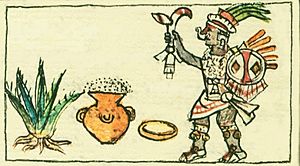Aguamiel facts for kids
Aguamiel (pronounced ah-wah-MYEL) means "honey water" in Spanish. It is a sweet liquid, or sap, that comes from the maguey plant. This plant grows in Mexico. People have used aguamiel for a very long time. They believe it has special healing powers.
The Story of Aguamiel
Long ago, in ancient Mexico, people discovered aguamiel. Native American stories say that a Toltec noble named Papantzin found out how to get this sap. This happened around the years 990 to 1042. Papantzin's daughter, Xochitl, brought aguamiel as a gift to King Tecpancaltzin.
You can find many maguey plants near the old ruins of the Teotihuacan civilization. These plants have been a part of Mexican culture for centuries.
How Aguamiel is Collected
Aguamiel is collected from the maguey plant. To get the sap, a farmer cuts the plant's growing flower stalk. This cut makes the plant release its sweet sap.
A single maguey plant can produce a lot of aguamiel. It can give about 1,000 liters (about 264 gallons) over three to six months. At the start and end of this time, the plant gives about 0.4 liters (about 0.1 gallons) per day. But at its peak, it can give 4 to 6 liters (about 1 to 1.5 gallons) each day. After the first cut, the plant can keep giving sap for up to two months.
Uses of Aguamiel
In Mexico, aguamiel has been used as a traditional medicine. It is also enjoyed as a drink. When aguamiel is fermented, it turns into a thick, beer-like drink. This drink is called pulque. People have been drinking pulque for hundreds of years.
Aguamiel was not widely used everywhere for a long time. This was because it would spoil quickly. But later, a way to make it more concentrated was developed. This helped it last longer and be shared more widely.
Commercial Use
Aguamiel started to be sold in stores around 1910. One company, Agmel Products Corporation, distributed it. Later, in March 1928, another company called Zonite Products Corporation bought Agmel Products. At first, aguamiel was mainly sold in California. This changed after late 1928, when it became more available.


